
Avery-MacLeod-McCarty experiment
Encyclopedia
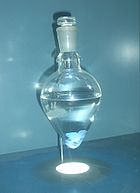
Oswald Avery
Oswald Theodore Avery ForMemRS was a Canadian-born American physician and medical researcher. The major part of his career was spent at the Rockefeller University Hospital in New York City...
, Colin MacLeod
Colin MacLeod
Colin Munro MacLeod was a Canadian-American geneticist.- Biography :Born in Port Hastings, Nova Scotia, Canada MacLeod entered McGill University at the age of 16 , and completed his medical studies by age 23.In his early years as a research scientist, MacLeod, together with Oswald Avery and...
, and Maclyn McCarty
Maclyn McCarty
Maclyn McCarty was an American geneticist.Maclyn McCarty, who devoted his life as a physician-scientist to studying infectious disease organisms, was best known for his part in the monumental discovery that DNA, rather than protein, constituted the chemical nature of a gene...
, that DNA
DNA
Deoxyribonucleic acid is a nucleic acid that contains the genetic instructions used in the development and functioning of all known living organisms . The DNA segments that carry this genetic information are called genes, but other DNA sequences have structural purposes, or are involved in...
is the substance that causes bacterial transformation. It was the culmination of research in the 1930s and early 1940s at the Rockefeller Institute for Medical Research to purify and characterize the "transforming principle" responsible for the transformation phenomenon first described in Griffith's experiment
Griffith's experiment
Griffith's experiment, reported in 1928 by Frederick Griffith, was one of the first experiments suggesting that bacteria are capable of transferring genetic information through a process known as transformation....
of 1928: killed Streptococcus pneumoniae
Streptococcus pneumoniae
Streptococcus pneumoniae, or pneumococcus, is Gram-positive, alpha-hemolytic, aerotolerant anaerobic member of the genus Streptococcus. A significant human pathogenic bacterium, S...
of the virulent strain type III-S, when injected along with living but non-virulent type II-R pneumococci, resulted in a deadly infection of type III-S pneumococci. In their paper "Studies on the Chemical Nature of the Substance Inducing Transformation of Pneumococcal Types: Induction of Transformation by a Deoxyribonucleic Acid Fraction Isolated from Pneumococcus Type III", published in the February 1944 issue of the Journal of Experimental Medicine
Journal of Experimental Medicine
The Journal of Experimental Medicine is a peer-reviewed academic journal published by the Rockefeller University Press that publishes research papers and commentaries on the physiological, pathological, and molecular mechanisms that encompass the host response to disease...
, Avery and his colleagues suggest that DNA, rather than protein as widely believed at the time, may be the hereditary material of bacteria, and could be analogous to gene
Gene
A gene is a molecular unit of heredity of a living organism. It is a name given to some stretches of DNA and RNA that code for a type of protein or for an RNA chain that has a function in the organism. Living beings depend on genes, as they specify all proteins and functional RNA chains...
s and/or virus
Virus
A virus is a small infectious agent that can replicate only inside the living cells of organisms. Viruses infect all types of organisms, from animals and plants to bacteria and archaea...
es in higher organisms.
Background
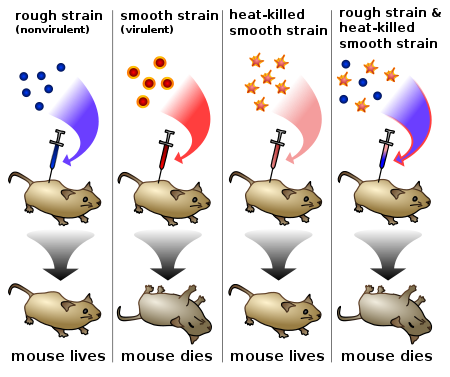
Strain (biology)
In biology, a strain is a low-level taxonomic rank used in three related ways.-Microbiology and virology:A strain is a genetic variant or subtype of a micro-organism . For example, a "flu strain" is a certain biological form of the influenza or "flu" virus...
, or types. When a person or test animal (e.g., a mouse
Mouse
A mouse is a small mammal belonging to the order of rodents. The best known mouse species is the common house mouse . It is also a popular pet. In some places, certain kinds of field mice are also common. This rodent is eaten by large birds such as hawks and eagles...
) is inoculated
Inoculation
Inoculation is the placement of something that will grow or reproduce, and is most commonly used in respect of the introduction of a serum, vaccine, or antigenic substance into the body of a human or animal, especially to produce or boost immunity to a specific disease...
with a particular type, an immune response ensues, generating antibodies that react specifically with antigens on the bacteria. Blood serum
Blood serum
In blood, the serum is the component that is neither a blood cell nor a clotting factor; it is the blood plasma with the fibrinogens removed...
containing the antibodies can then be extracted and applied to cultured bacteria. The antibodies will react with other bacteria of the same type as the original inoculation. Fred Neufeld
Fred Neufeld
Fred Neufeld was a physician and bacteriologist who discovered the pneumococcal types. This discovery led Fred Griffith to show that one pneumococcal type could be transformed into another . Subsequently, Oswald Avery demonstrated that the transforming substance was DNA...
, a German bacteriologist, had discovered the pneumococcal types and serological typing; until Frederick Griffith
Frederick Griffith
Frederick Griffith was a British bacteriologist whose focus was the epidemiology and pathology of bacterial pneumonia. In January 1928 he reported what is now known as Griffith's Experiment, the first widely accepted demonstrations of bacterial transformation, whereby a bacterium distinctly...
's studies bacteriologists believed that the types were fixed and unchangeable from one generation to the next.
Griffith's experiment
Griffith's experiment
Griffith's experiment, reported in 1928 by Frederick Griffith, was one of the first experiments suggesting that bacteria are capable of transferring genetic information through a process known as transformation....
, reported in 1928, identified that some "transforming principle" in pneumococcal bacteria could transform them from one type to another. Griffith, a British medical officer, had spent years applying serological typing to cases of pneumonia
Pneumonia
Pneumonia is an inflammatory condition of the lung—especially affecting the microscopic air sacs —associated with fever, chest symptoms, and a lack of air space on a chest X-ray. Pneumonia is typically caused by an infection but there are a number of other causes...
, a frequently fatal disease in the early 20th century. He found that multiple types—some virulent and some non-virulent—were often present over the course of a clinical case of pneumonia, and thought that one type might change into another (rather than simply multiple types being present all along). In testing that possibility, he found that transformation could occur when dead bacteria of a virulent type and live bacteria of a non-virulent type were both injected in mice: the mice would develop a fatal infection (normally only caused by live bacteria of the virulent type) and live, virulent bacteria could be isolated from such infected mice.
The findings of Griffith's experiment were soon confirmed, first by Fred Neufeld
Fred Neufeld
Fred Neufeld was a physician and bacteriologist who discovered the pneumococcal types. This discovery led Fred Griffith to show that one pneumococcal type could be transformed into another . Subsequently, Oswald Avery demonstrated that the transforming substance was DNA...
at the Koch Institute
Koch Institute
The Koch Institute refers to several different institutions:* Robert Koch Institute, a disease control and prevention institute headquartered in Berlin, Germany...
and by Martin Henry Dawson
Martin Henry Dawson
Martin Henry Dawson was a Canadian-born researcher who made important contributions in the fields of infectious diseases....
at the Rockefeller Institute. A series of Rockefeller Institute researchers continued to study transformation in the years that followed. With Richard H.P. Sia, Dawson developed a method of transforming bacteria in vitro
In vitro
In vitro refers to studies in experimental biology that are conducted using components of an organism that have been isolated from their usual biological context in order to permit a more detailed or more convenient analysis than can be done with whole organisms. Colloquially, these experiments...
(rather than in vivo
In vivo
In vivo is experimentation using a whole, living organism as opposed to a partial or dead organism, or an in vitro controlled environment. Animal testing and clinical trials are two forms of in vivo research...
as Griffith had done). After Dawson's departure in 1930, James Alloway took up the attempt to extend Griffith's findings, resulting in the extraction of aqueous solution
Aqueous solution
An aqueous solution is a solution in which the solvent is water. It is usually shown in chemical equations by appending aq to the relevant formula, such as NaCl. The word aqueous means pertaining to, related to, similar to, or dissolved in water...
s of the transforming principle by 1933. Colin MacLeod worked to purify such solutions from 1934 to 1937, and the work was continued in 1940 and completed by Maclyn McCarty.
Experimental work
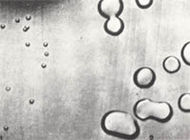
Antibody
An antibody, also known as an immunoglobulin, is a large Y-shaped protein used by the immune system to identify and neutralize foreign objects such as bacteria and viruses. The antibody recognizes a unique part of the foreign target, termed an antigen...
formation; the different types are classified according to their immunological specificity.
The purification procedure consisted of first killing the bacteria with heat and extracting
Leaching (chemical science)
Leaching is the process of extracting minerals from a solid by dissolving them in a liquid, either in nature or through an industrial process. In the chemical processing industry, leaching has a variety of commercial applications, including separation of metal from ore using acid, and sugar from...
the saline
Saline water
Saline water is a general term for water that contains a significant concentration of dissolved salts . The concentration is usually expressed in parts per million of salt....
-soluble components. Next, the protein was precipitated
Precipitation (chemistry)
Precipitation is the formation of a solid in a solution or inside anothersolid during a chemical reaction or by diffusion in a solid. When the reaction occurs in a liquid, the solid formed is called the precipitate, or when compacted by a centrifuge, a pellet. The liquid remaining above the solid...
out using chloroform
Chloroform
Chloroform is an organic compound with formula CHCl3. It is one of the four chloromethanes. The colorless, sweet-smelling, dense liquid is a trihalomethane, and is considered somewhat hazardous...
and the polysaccharide capsules were hydrolyzed
Hydrolysis
Hydrolysis is a chemical reaction during which molecules of water are split into hydrogen cations and hydroxide anions in the process of a chemical mechanism. It is the type of reaction that is used to break down certain polymers, especially those made by condensation polymerization...
with an enzyme
Enzyme
Enzymes are proteins that catalyze chemical reactions. In enzymatic reactions, the molecules at the beginning of the process, called substrates, are converted into different molecules, called products. Almost all chemical reactions in a biological cell need enzymes in order to occur at rates...
. An immunological precipitation caused by type-specific antibodies was used to verify the complete destruction of the capsules. Then, the active portion was precipitated out by alcohol fractionation
Fractionation
See also: Fractionated spacecraftFractionation is a separation process in which a certain quantity of a mixture is divided up in a number of smaller quantities in which the composition changes according to a gradient. Fractions are collected based on differences in a specific property of the...
, resulting in fibrous strands that could be removed with a stirring rod.
Chemical analysis showed that the proportions of carbon, hydrogen, nitrogen, and phosphorus in this active portion were consistent with the chemical composition of DNA. To show that it was DNA rather than some small amount of RNA
RNA
Ribonucleic acid , or RNA, is one of the three major macromolecules that are essential for all known forms of life....
, protein
Protein
Proteins are biochemical compounds consisting of one or more polypeptides typically folded into a globular or fibrous form, facilitating a biological function. A polypeptide is a single linear polymer chain of amino acids bonded together by peptide bonds between the carboxyl and amino groups of...
, or some other cell component that was responsible for transformation, Avery and his colleagues used a number of biochemical tests. They found that trypsin
Trypsin
Trypsin is a serine protease found in the digestive system of many vertebrates, where it hydrolyses proteins. Trypsin is produced in the pancreas as the inactive proenzyme trypsinogen. Trypsin cleaves peptide chains mainly at the carboxyl side of the amino acids lysine or arginine, except when...
, chymotrypsin
Chymotrypsin
Chymotrypsin is a digestive enzyme that can perform proteolysis. Chymotrypsin preferentially cleaves peptide amide bonds where the carboxyl side of the amide bond is a tyrosine, tryptophan, or phenylalanine. These amino acids contain an aromatic ring in their sidechain that fits into a...
and ribonuclease
Ribonuclease
Ribonuclease is a type of nuclease that catalyzes the degradation of RNA into smaller components. Ribonucleases can be divided into endoribonucleases and exoribonucleases, and comprise several sub-classes within the EC 2.7 and 3.1 classes of enzymes.-Function:All organisms studied contain...
(enzymes that break apart proteins or RNA) did not affect it, but an enzyme preparation of "deoxyribonucleodepolymerase" (a crude preparation, obtainable from a number of animal sources, that could break down DNA) destroyed the extract's transforming power.
Followup work in response to criticism and challenges included the purification and crystallization, by Moses Kunitz in 1948, of a DNA depolymerase (deoxyribonuclease I
Deoxyribonuclease I
Deoxyribonuclease I , is an endonuclease coded by the human gene DNASE1.DNase I is a nuclease that cleaves DNA preferentially at phosphodiester linkages adjacent to a pyrimidine nucleotide, yielding 5'-phosphate-terminated polynucleotides with a free hydroxyl group on position 3', on average...
), and precise work by Rollin Hotchkiss
Rollin Hotchkiss
Rollin Douglas Hotchkiss was an American biochemist who helped to establish the role of DNA as the genetic material and contributed to the isolation and purification of the first antibiotics. His work on bacterial transformation helped lay the groundwork for the field of molecular...
showing that virtually all the detected nitrogen in the purified DNA came from glycine
Glycine
Glycine is an organic compound with the formula NH2CH2COOH. Having a hydrogen substituent as its 'side chain', glycine is the smallest of the 20 amino acids commonly found in proteins. Its codons are GGU, GGC, GGA, GGG cf. the genetic code.Glycine is a colourless, sweet-tasting crystalline solid...
, a breakdown product of the nucleotide base adenine
Adenine
Adenine is a nucleobase with a variety of roles in biochemistry including cellular respiration, in the form of both the energy-rich adenosine triphosphate and the cofactors nicotinamide adenine dinucleotide and flavin adenine dinucleotide , and protein synthesis, as a chemical component of DNA...
, and that undetected protein contamination was at most 0.02% by Hotchkiss's estimation.
Reception and legacy
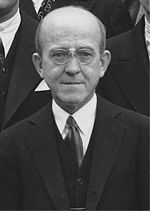
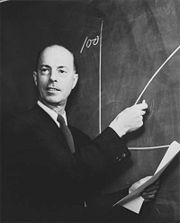
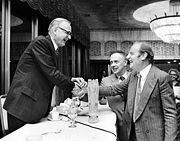
Phoebus Levene
Phoebus Aaron Theodore Levene, M.D. was a Russian-American biochemist who studied the structure and function of nucleic acids...
's influential "tetranucleotide hypothesis", DNA consisted of repeating units of the four nucleotide bases and had little biological specificity. DNA was therefore thought to be the structural component of chromosome
Chromosome
A chromosome is an organized structure of DNA and protein found in cells. It is a single piece of coiled DNA containing many genes, regulatory elements and other nucleotide sequences. Chromosomes also contain DNA-bound proteins, which serve to package the DNA and control its functions.Chromosomes...
s, whereas the genes were thought likely to be made of the protein component of chromosomes. This line of thinking was reinforced by the 1935 crystallization of tobacco mosaic virus
Tobacco mosaic virus
Tobacco mosaic virus is a positive-sense single stranded RNA virus that infects plants, especially tobacco and other members of the family Solanaceae. The infection causes characteristic patterns on the leaves . TMV was the first virus to be discovered...
by Wendell Stanley, and the parallels among viruses, genes, and enzymes; many biologists thought genes might be a sort of "super-enzyme", and viruses were shown according to Stanley to be proteins and to share the property of autocatalysis
Autocatalysis
A single chemical reaction is said to have undergone autocatalysis, or be autocatalytic, if the reaction product itself is the catalyst for that reaction....
with many enzymes. Furthermore, few biologists thought that genetics could be applied to bacteria, since they lacked chromosome
Chromosome
A chromosome is an organized structure of DNA and protein found in cells. It is a single piece of coiled DNA containing many genes, regulatory elements and other nucleotide sequences. Chromosomes also contain DNA-bound proteins, which serve to package the DNA and control its functions.Chromosomes...
s and sexual reproduction
Sexual reproduction
Sexual reproduction is the creation of a new organism by combining the genetic material of two organisms. There are two main processes during sexual reproduction; they are: meiosis, involving the halving of the number of chromosomes; and fertilization, involving the fusion of two gametes and the...
. In particular, many of the geneticists known informally as the phage group
Phage group
The phage group was an informal network of biologists centered around Max Delbrück that contributed heavily to bacterial genetics and the origins of molecular biology in the mid-20th century. The phage group takes its name from bacteriophages, the bacteria-infecting viruses that group used as...
, which would become influential in the new discipline of molecular biology
Molecular biology
Molecular biology is the branch of biology that deals with the molecular basis of biological activity. This field overlaps with other areas of biology and chemistry, particularly genetics and biochemistry...
in the 1950s, were dismissive of DNA as the genetic material (and were inclined to avoid the "messy" biochemical approaches of Avery and his colleagues). Some biologists, including fellow Rockefeller Institute Fellow Alfred Mirsky
Alfred Mirsky
Alfred Ezra Mirsky was an American pioneer in molecular biology.Mirsky graduated from Harvard College in 1922, after which he studied for two years at the Columbia University College of Physicians and Surgeons until 1924 when he moved to the University of Cambridge on a US National Research...
, challenged Avery's finding that the transforming principle was pure DNA, suggesting that protein contaminants were instead responsible. Although transformation occurred in some kinds of bacteria, it could not be replicated in other bacteria (nor in any higher organisms), and its significance seemed limited primarily to medicine.
Scientists looking back on the Avery–MacLeod–McCarty experiment have disagreed about just how influential it was in the 1940s and early 1950s. Gunther Stent
Gunther Stent
Gunther S. Stent was Graduate Professor of Molecular Biology at the University of California, Berkeley. He was born in Berlin as "Günter Siegmund Stensch"; the name was changed after the migration to the USA...
suggested that it was largely ignored, and only celebrated afterwards—similarly to Gregor Mendel
Gregor Mendel
Gregor Johann Mendel was an Austrian scientist and Augustinian friar who gained posthumous fame as the founder of the new science of genetics. Mendel demonstrated that the inheritance of certain traits in pea plants follows particular patterns, now referred to as the laws of Mendelian inheritance...
's work decades before the rise of genetics
Genetics
Genetics , a discipline of biology, is the science of genes, heredity, and variation in living organisms....
. Others, such as Joshua Lederberg
Joshua Lederberg
Joshua Lederberg ForMemRS was an American molecular biologist known for his work in microbial genetics, artificial intelligence, and the United States space program. He was just 33 years old when he won the 1958 Nobel Prize in Physiology or Medicine for discovering that bacteria can mate and...
and Leslie C. Dunn, attest to its early significance and cite the experiment as the beginning of molecular genetics
Molecular genetics
Molecular genetics is the field of biology and genetics that studies the structure and function of genes at a molecular level. The field studies how the genes are transferred from generation to generation. Molecular genetics employs the methods of genetics and molecular biology...
.
A few microbiologists and geneticists had taken an interest in the physical and chemical nature of genes before 1944, but the Avery–MacLeod–McCarty experiment brought renewed and wider interest in the subject. While the original publication did not mention genetics specifically, Avery as well as many of the geneticists who read the paper were aware of the genetic implications—that Avery may have isolated the gene itself as pure DNA. Biochemist Erwin Chargaff
Erwin Chargaff
Erwin Chargaff was an American biochemist who emigrated to the United States during the Nazi era. Through careful experimentation, Chargaff discovered two rules that helped lead to the discovery of the double helix structure of DNA...
, geneticist H. J. Muller and others praised the result as establishing the biological specificity of DNA and as having important implications for genetics if DNA played a similar role in higher organisms. In 1945, the Royal Society
Royal Society
The Royal Society of London for Improving Natural Knowledge, known simply as the Royal Society, is a learned society for science, and is possibly the oldest such society in existence. Founded in November 1660, it was granted a Royal Charter by King Charles II as the "Royal Society of London"...
awarded Avery the Copley Medal
Copley Medal
The Copley Medal is an award given by the Royal Society of London for "outstanding achievements in research in any branch of science, and alternates between the physical sciences and the biological sciences"...
, in part for his work on bacterial transformation.
Between 1944 and 1954, the paper was cited at least 239 times (with citations spread evenly though those years), mostly in papers on microbiology, immunochemistry, and biochemistry. In addition to the follow-up work by McCarty and others at the Rockefeller Institute in response to Mirsky's criticisms, the experiment spurred considerable work in microbiology, where it shed new light on the analogies between bacterial heredity and the genetics of sexually-reproducing organisms. French microbiologist André Boivin claimed to extend Avery's bacterial transformation findings to Escherichia coli
Escherichia coli
Escherichia coli is a Gram-negative, rod-shaped bacterium that is commonly found in the lower intestine of warm-blooded organisms . Most E. coli strains are harmless, but some serotypes can cause serious food poisoning in humans, and are occasionally responsible for product recalls...
, although this could not be confirmed by other researchers. In 1946, however, Joshua Lederberg and Edward Tatum demonstrated bacterial conjugation
Bacterial conjugation
Bacterial conjugation is the transfer of genetic material between bacterial cells by direct cell-to-cell contact or by a bridge-like connection between two cells...
in E. coli and showed that genetics could apply to bacteria, even if Avery's specific method of transformation was not general. Avery's work also may have played a role in the continuation of X-ray crystallography
X-ray crystallography
X-ray crystallography is a method of determining the arrangement of atoms within a crystal, in which a beam of X-rays strikes a crystal and causes the beam of light to spread into many specific directions. From the angles and intensities of these diffracted beams, a crystallographer can produce a...
studies of DNA by Maurice Wilkins
Maurice Wilkins
Maurice Hugh Frederick Wilkins CBE FRS was a New Zealand-born English physicist and molecular biologist, and Nobel Laureate whose research contributed to the scientific understanding of phosphorescence, isotope separation, optical microscopy and X-ray diffraction, and to the development of radar...
, who faced pressure from his funders to make whole cells, rather than biological molecules, the subject of his research.
Despite the significant number of citations to the paper and positive responses it received in the years following publication, Avery's work was largely neglected by much of the scientific community. Although received positively by many scientists, the experiment did not seriously affect mainstream genetics research, in part because it made little difference for classical genetics experiments in which genes were defined by their behavior in breeding experiments rather than their chemical makeup. H. J. Muller, while interested, was focused more on physical rather than chemical studies of the gene, as were most of the members of the phage group
Phage group
The phage group was an informal network of biologists centered around Max Delbrück that contributed heavily to bacterial genetics and the origins of molecular biology in the mid-20th century. The phage group takes its name from bacteriophages, the bacteria-infecting viruses that group used as...
. Avery's work was also neglected by the Nobel Foundation
Nobel Foundation
The Nobel Foundation is a private institution founded on 29 June 1900 to manage the finances and administration of the Nobel Prizes. The Foundation is based on the last will of Alfred Nobel, the inventor of dynamite....
, which later expressed public regret for failing to award Avery a Nobel Prize
Nobel Prize
The Nobel Prizes are annual international awards bestowed by Scandinavian committees in recognition of cultural and scientific advances. The will of the Swedish chemist Alfred Nobel, the inventor of dynamite, established the prizes in 1895...
.
By the time of the 1952 Hershey–Chase experiment, geneticists were more inclined to consider DNA as the genetic material, and Alfred Hershey
Alfred Hershey
Alfred Day Hershey was an American Nobel Prize-winning bacteriologist and geneticist.He was born in Owosso, Michigan and received his B.S. in chemistry at Michigan State University in 1930 and his Ph.D. in bacteriology in 1934, taking a position shortly thereafter at the Department of Bacteriology...
was an influential member of the phage group. Erwin Chargaff had shown that the base composition of DNA varies by species (contrary to the tetranucleotide hypothesis), and in 1952 Rollin Hotchkiss published his experimental evidence both confirming Chargaff's work and demonstrating the absence of protein in Avery's transforming principle. Furthermore, the field of bacterial genetics
Bacterial genetics
Bacterial genetics is the subfield of genetics devoted to the study of bacteria. Bacterial genetics are subtly different from eukaryotic genetics, however bacteria still serve as a good model for animal genetic studies. One of the major distinctions between bacterial and eukaryotic genetics stems...
was quickly becoming established, and biologists were more inclined to think of heredity in the same terms for bacteria and higher organisms. After Hershey and Chase used radioactive isotopes to show that it was primarily DNA, rather than protein, that entered bacteria upon infection with bacteriophage
Bacteriophage
A bacteriophage is any one of a number of viruses that infect bacteria. They do this by injecting genetic material, which they carry enclosed in an outer protein capsid...
, it was soon widely accepted that DNA was the genetic material. Despite the much less precise experimental results (they found a not-insignificant amount of protein entering the cells as well as DNA), the Hershey–Chase experiment was not subject to the same degree of challenge. Its influence was boosted by the growing network of the phage group and, the following year, by the publicity surrounding the DNA structure proposed by Watson and Crick
Watson and Crick
James D. Watson and Francis Crick were the two co-discoverers of the structure of DNA in 1953. They used x-ray diffraction data collected by Rosalind Franklin and proposed the double helix or spiral staircase structure of the DNA molecule...
(Watson was also a member of the phage group). Only in retrospect, however, did either experiment definitively prove that DNA is the genetic material.
External links
- DNA: The Search for the Genetic Material Avery, MacLeod and McCarty's Experiment for the Advanced Science Hobbyist.

